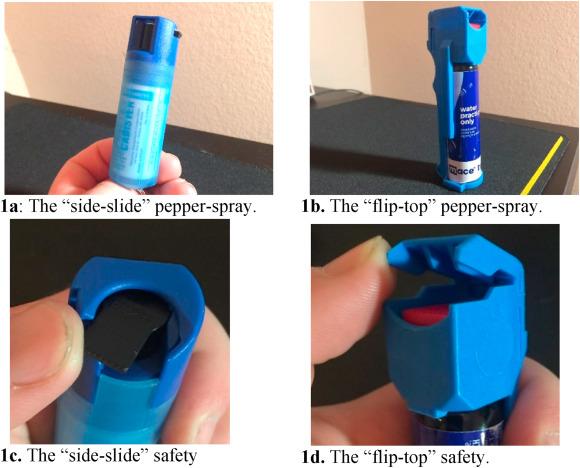Table of Contents
- Experts Highlight Risks of Improper Pepper Spray Storage Around Children and Animals
- Safe Storage Practices Recommended to Prevent Accidental Exposure in Homes
- Choosing Secure Containers and Locations to Protect Vulnerable Family Members
- Guidance on Educating Family About Pepper Spray Safety and Emergency Response
- To Wrap It Up
Experts Highlight Risks of Improper Pepper Spray Storage Around Children and Animals
Storing pepper spray in easily accessible locations poses significant dangers to children and pets who may unknowingly come into contact with the substance. Experts warn that even small amounts of accidental exposure can cause severe respiratory distress, skin irritation, and eye injuries. In households with young children, impulsive behavior combined with a lack of understanding about the spray’s harmful effects increases the risk of unintended mishaps. Similarly, curious animals attracted to the canister may suffer from painful reactions or distress if they interact with improperly kept pepper spray.
To mitigate these risks, specialists recommend adhering to strict safety measures including:
- Secure storage: Keep pepper spray in high, locked cabinets or containers that children and pets cannot reach.
- Clear labeling: Mark the container prominently to avoid accidental misuse.
- Immediate reporting: If exposure occurs, seek prompt medical or veterinary attention to reduce harm.
- Education: Ensure all household members understand the dangers and proper handling of pepper spray devices.
Safe Storage Practices Recommended to Prevent Accidental Exposure in Homes
To minimize the risk of accidental exposure to pepper spray within the household, experts emphasize the importance of securely locking away these devices. It is recommended that pepper spray containers be stored in locations inaccessible to children and pets, such as high shelves or locked cabinets. Keeping the spray in a clearly labeled, tamper-proof case can also prevent unintentional handling. Experts advise against placing it in common areas like kitchen drawers or bathroom cabinets, where curious young ones or animals may easily come into contact with the substance.
Adopting proper storage techniques includes adhering to the following safety tips:
- Use child-resistant locks on all storage containers housing pepper spray.
- Store the device separately from other personal items to avoid accidental misuse.
- Clearly educate all household members on the location and risks associated with pepper spray.
- Regularly inspect containers for leaks, damage, or expiration dates to maintain safety.
Choosing Secure Containers and Locations to Protect Vulnerable Family Members
When it comes to securing pepper spray, experts emphasize the necessity of selecting containers that are both child-resistant and pet-proof. Items that feature strong locking mechanisms, such as combination locks or safety caps, are highly recommended to prevent accidental access. Furthermore, the materials used should be durable and resistant to tampering or leakage, ensuring the spray remains effective and safe within the storage unit.
Optimal storage locations should be chosen with the entire household’s safety in mind. Experts suggest placing pepper spray in:
- High, out-of-reach cabinets or shelves, especially those equipped with child locks
- Locked safes or secure boxes that are clearly labeled and accessible only to authorized adults
- Designated security zones within the home – away from common play areas, pet feeding stations, and frequently trafficked rooms
Guidance on Educating Family About Pepper Spray Safety and Emergency Response
Educating your family about pepper spray safety is crucial to prevent accidental exposures and ensure timely responses in case of emergencies. Start by clearly explaining the purpose of pepper spray and emphasizing that it is not a toy. Store the device in a secure, out-of-reach location to protect children and pets from accidental intoxication. Make it a family rule that only responsible adults should handle pepper spray, and never bring it into casual conversation or situations that could make children curious. Reinforce these points through regular, calm discussions that foster respect and caution.
Preparing your household for potential scenarios involving pepper spray means establishing an emergency response plan. This includes teaching family members to avoid rubbing eyes or face if contacted and to wash affected areas thoroughly with cold water, while seeking fresh air immediately. It is equally important to know when to seek professional medical help, especially if symptoms worsen. Consider posting quick-reference instructions on the fridge or another visible spot that outlines:
- Steps to administer first aid
- Emergency contact numbers
- Location of the pepper spray device
To Wrap It Up
As concerns over accidental exposure continue to rise, experts emphasize the critical importance of storing pepper spray securely and out of reach of children and pets. Proper storage not only prevents unintended harm but also ensures the device remains effective when genuinely needed for self-defense. Consumers are encouraged to follow manufacturer guidelines and consider lockable storage solutions to promote safety within the home. Staying informed and vigilant is key to protecting all members of the household while maintaining personal security.Check Our Other Blogs
- StunGun – Your Trusted Source for Stun Guns, Laws, and Self-Defense Tips
- PepperSprayLaws – Your Trusted Resource for Pepper Spray Information
- StunGunLaws – Your Trusted Guide to Stun Gun Legality and Safety




